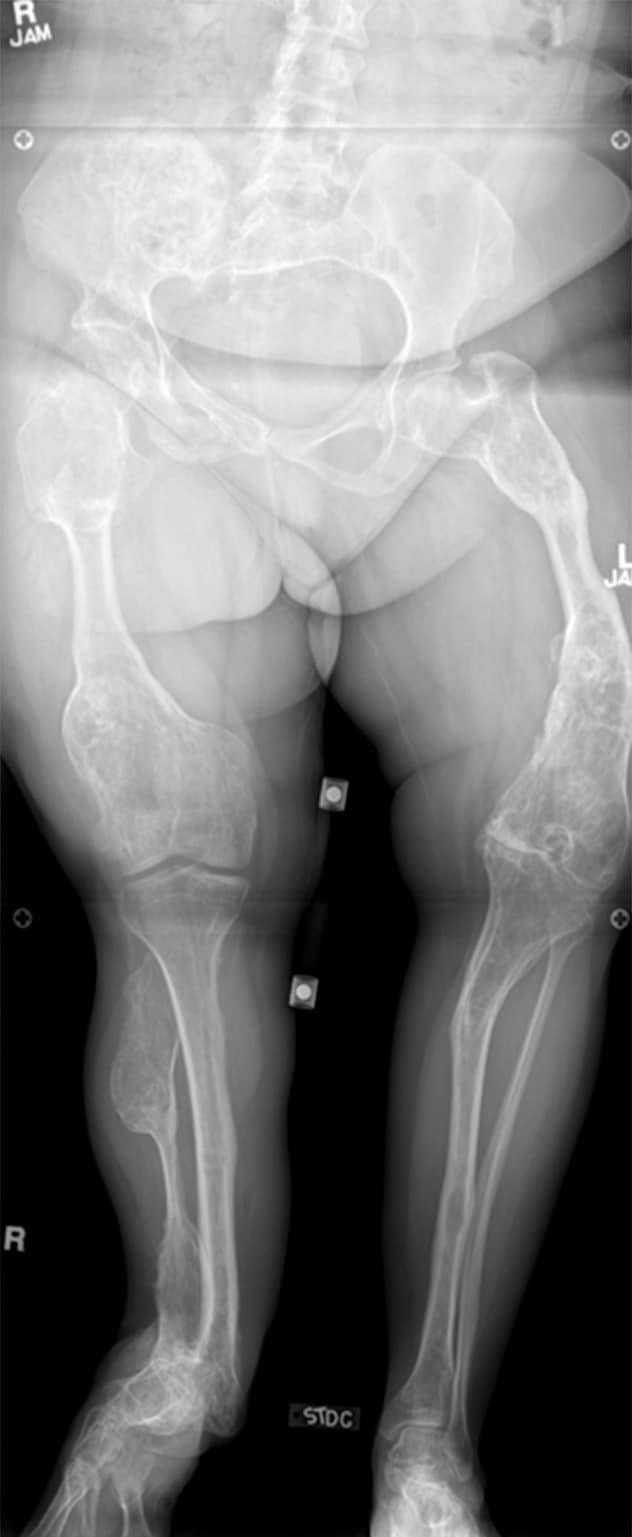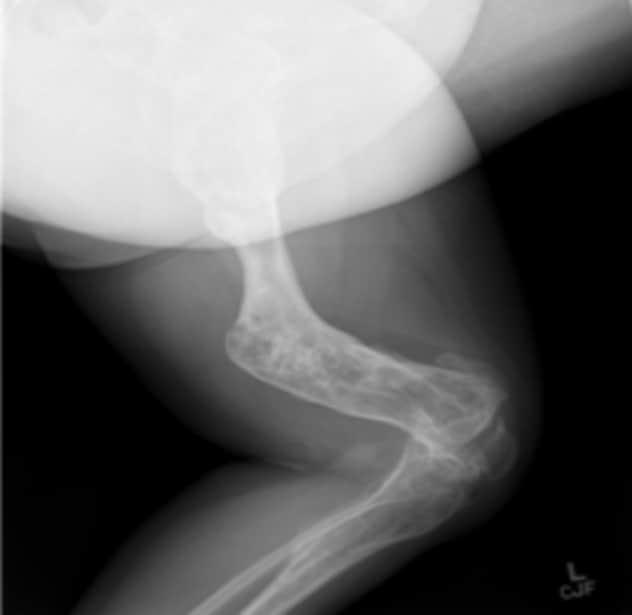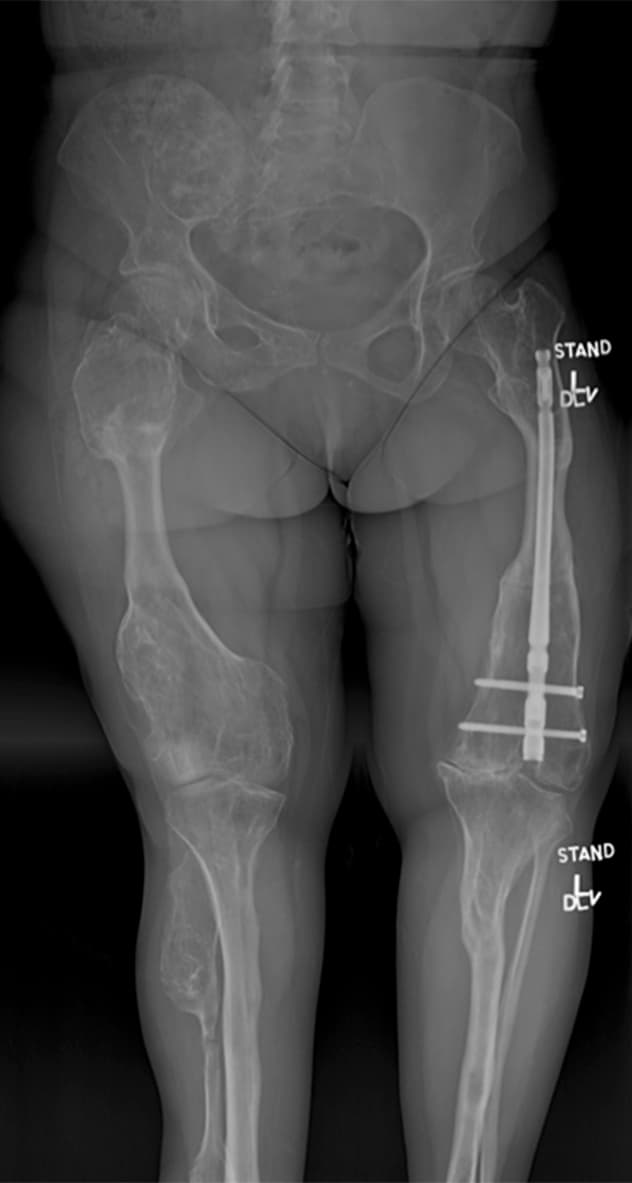Feb. 20, 2021
The causes of limb deformities are variable and often complex. Mayo Clinic's Limb Lengthening and Regeneration Clinic in Minnesota takes a multidisciplinary approach aimed at maximizing function while managing any underlying disorders.
"Many of these patients require attention from more than just an orthopedic surgeon, because many limb deformities involve more than just bone. Access to the resources of multiple specialists in multiple fields is really beneficial," says Stephen (Andy) A. Sems, M.D., an orthopedic surgeon at Mayo Clinic in Rochester, Minnesota.
الأشعة السينية لامرأة تبلغ من العمر 55 عامًا تعاني من داء أوليير

الأشعة السينية لامرأة تبلغ من العمر 55 عامًا تعاني من داء أوليير
توضح الأشعة السينية علاج امرأة تبلغ من العمر 55 عامًا، تعاني من داء أوليير في عيادة مايو كلينك لإطالة وتجديد الأطراف في ولاية مينيسوتا، حيث تعاني المريضة من ألم في الركبة اليسري وتشوهات ثنائية في الأطراف السفلية، بما فيها القدم اليمنى والكاحل الأيمن، مع وجود فرق بين طول الساقين. تعاوَن اختصاصي القدم والكاحل وطبيب أورام العظام واختصاصي تشوه الأطراف العظمية معًا لتنسيق العلاج الجراحي للمريضة.
الأشعة السينية لامرأة تبلغ من العمر 55 عامًا تعاني من داء أوليير

الأشعة السينية لامرأة تبلغ من العمر 55 عامًا تعاني من داء أوليير
توضح الأشعة السينية علاج امرأة تبلغ من العمر 55 عامًا، تعاني من داء أوليير في عيادة مايو كلينك لإطالة وتجديد الأطراف في ولاية مينيسوتا، حيث تعاني المريضة من ألم في الركبة اليسري وتشوهات ثنائية في الأطراف السفلية، بما فيها القدم اليمنى والكاحل الأيمن، مع وجود فرق بين طول الساقين.
علاج داء أوليير

علاج داء أوليير
تعاوَن اختصاصيو القدم والكاحل وأورام العظام وتشوه الأطراف العظمية معًا لتنسيق العلاج بالتدخل الجراحي للمريضة: قطع العظم الفخذي والظنبوبي الأيسر عن طريق تثبيت المسامير داخل نخاع عظم الفخذ وتثبيت حلقة متعددة المسطحات في عظمة الظنبوب، تليها إطالة عظمة الظنبوب اليمنى وقطع العظم العقبي الأيمن وإجراء الالتحام.
Managing care for both children and adults, the limb lengthening clinic brings together experts in several orthopedic surgery subspecialties, including orthopedic trauma, pediatric orthopedics and orthopedic oncology. Plastic and reconstructive surgeons, medical geneticists, endocrinologists and radiologists also are part of the team. Individualized treatment recommendations are made based on the combined input of all team members. The treatment options are as varied as the sources of the deformities, and external or internal fixation can be provided, depending on the individual patient's needs.
The patient experience
Mayo requests referring physicians to send as much information as possible about patients before they are seen at the limb lengthening clinic. "We gather a group of specialists, based on a patient's individual situation, to review that information," Dr. Sems says. "We then try to set up a flow of consultations with individual specialists, to minimize the patient's trips to Mayo."
For example, a patient with an underlying metabolic disorder would see an endocrinologist as well as various surgeons. "The limb deformity might require soft tissue procedures, such as flaps or nerve releases, which would need the involvement of a microvascular surgeon," Dr. Sems says. "Depending on where the deformity occurs, we have foot and ankle surgeons, and hand and upper extremity surgeons. If the deformity involves a residual amputation, we have a specialist with experience in those conditions."
Each of these specialists routinely sees patients in the limb lengthening clinic. Having a core group of specialists helps ensure that the team has experience with patients' varied conditions, even rare disorders.
"We don't just put in a referral to endocrinology. For example, there are two endocrinologists we typically work with, along with two specific hand surgeons, one foot and ankle surgeon, two pediatric surgeons, and one geneticist," Dr. Sems says. "Our familiarity with one another creates a sense of teamwork and an understanding of these patients."
As a major tertiary center, Mayo Clinic offers the full range of treatment options. These include lengthening rods, external fixation, and other implantable devices made from metals or polyether ether ketone (PEEK) polymers that can change limb angles.
"New technology has revolutionized how limb lengthening is approached," Dr. Sems says. "Many of our patients tell us after treatment that this is the first time they've had a functioning or well-aligned limb in as long as they can remember. Allowing our surgeons to focus on their areas of expertise contributes to giving patients the best possible outcomes."
For more information
Limb Lengthening and Regeneration Clinic in Minnesota. Mayo Clinic.